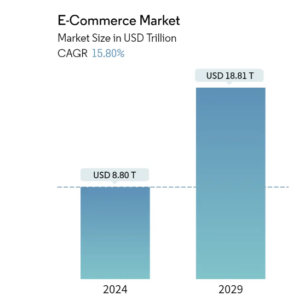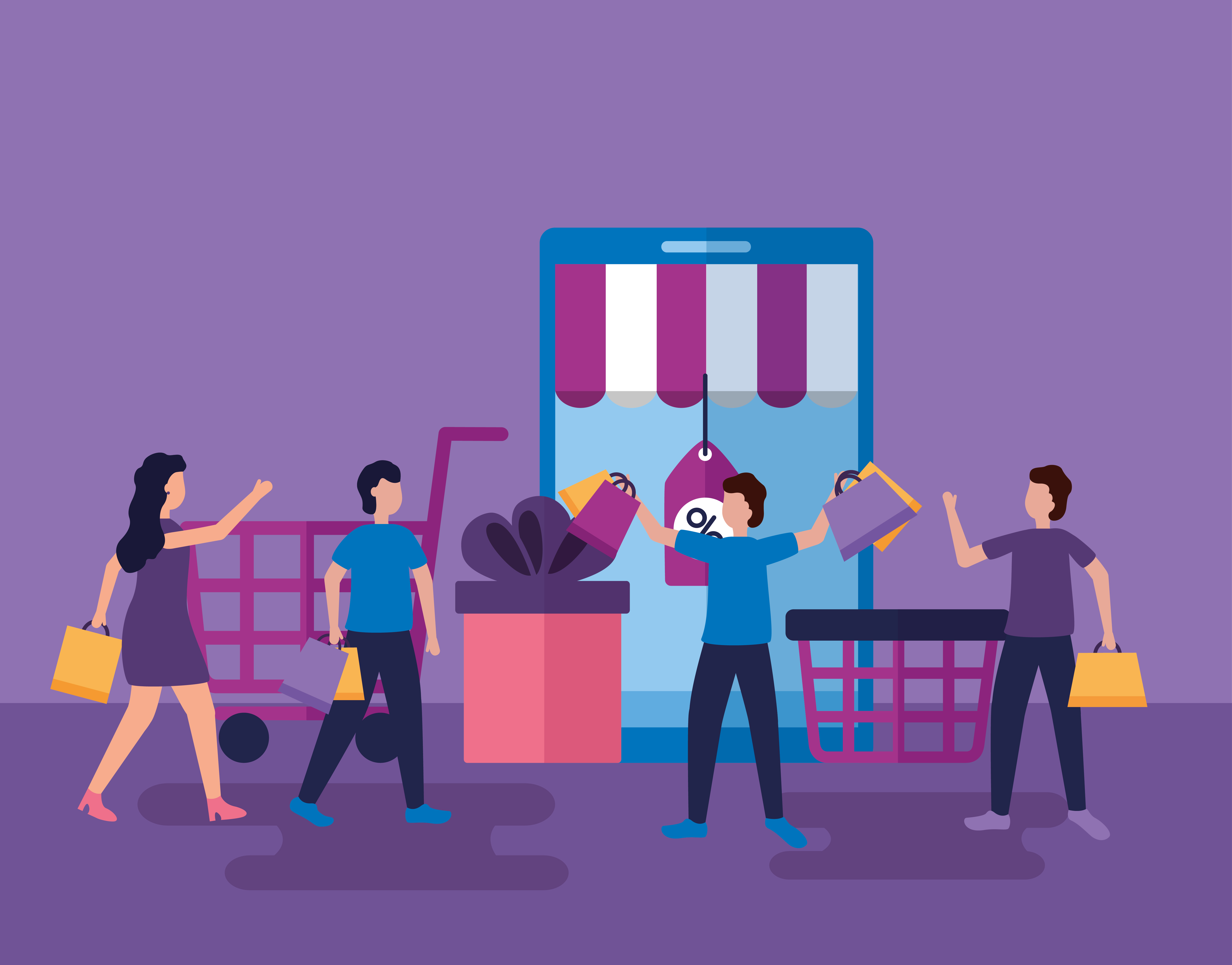
Top 14 E-commerce Trends in 2024: Shaping the Future of Online Retail
In the ever-evolving landscape of e-commerce, staying ahead of the curve is crucial for success. According to various sources, the global e-commerce market size is estimated to be around $8.8 trillion in 2024 and $18.8 trillion in 2030, growing at a compound annual growth rate (CAGR) of 15.8% from 2024 to 2030. (Source: Statista, Mordor Intelligence, Grandview Research). The top countries leading in e-commerce are China, the United States, the United Kingdom, Japan, and South Korea, based on their expected e-commerce revenue in 2024. China is expected to generate over $3 trillion in e-commerce sales in 2024, followed by the US with nearly $1.2 trillion. (Source: Oberlo, Statista and Business.com). As we step into 2024, let’s explore the trends that will dominate the digital marketplace and revolutionize how businesses engage with consumers. Buckle up for a journey through cutting-edge strategies, data-driven insights, and real-world examples.

E-commerce Market Size Globally (Source: Mordor Intelligence)

India: e-commerce market size 2030 | Statista
1. Seamless Omnichannel Experiences
Consumers no longer shop in silos. They seamlessly transition between online platforms, social media, and physical stores. To thrive in 2024, retailers must maintain a cohesive brand presence across all touchpoints. Unifying the customer journey ensures that shoppers can seamlessly continue their buying process, whether they’re browsing on Instagram, Amazon, or in-store. Brands like Nike have mastered this approach, providing consistent experiences across channels.
2. Artificial Intelligence (AI) Revolution
AI isn’t just a buzzword; it’s a game-changer. From personalized recommendations to chatbots handling customer queries, AI enhances efficiency and engagement. Retailers who embrace AI-driven solutions will gain a competitive edge. For instance, Sephora uses AI-powered virtual try-ons, allowing customers to test makeup virtually before purchasing.
Suggested Read: Generative AI use cases in healthcare | Top Healthcare Trends in 2024
3. Social Commerce Takes Center Stage
Social media isn’t just for scrolling; it’s a shopping hub. Brands are integrating direct purchasing options within platforms like Instagram and TikTok. As younger generations flock to social commerce, companies like Fashion Nova leverage influencers to drive sales and create a seamless shopping experience.
Suggested Read: Top Retails Trends in 2024
4. Sustainability Matters
Eco-conscious consumers demand transparency and ethical practices. Brands like Patagonia lead the way by emphasizing sustainable materials, fair trade, and environmental responsibility. Expect sustainability to shape purchasing decisions in 2024.

5. Personalized Customer Service
Chatbots and AI-driven customer service enhance responsiveness. Companies like Zappos prioritize personalized interactions, ensuring customer satisfaction and loyalty.
6. Voice Search Optimization
With voice assistants becoming ubiquitous, optimizing for voice search is essential. Brands like Walmart invest in voice-friendly content to capture this growing market.
Suggested Read: Brand Equity Research – everything you need to know | Metaverse in Market Research
7. Mobile-First UX Design
Mobile devices dominate e-commerce. Brands like ASOS focus on mobile-friendly interfaces, ensuring seamless navigation and quick transactions.
8. ROPO (Research Online, Purchase Offline)
Consumers research online but often buy in-store. Brands like Best Buy bridge the gap by integrating online and offline experiences.

9. AR and VR-Enhanced Shopping
Virtual try-ons and immersive experiences redefine online shopping. IKEA lets customers visualize furniture in their homes using AR. AR and VR e-commerce is expected to reach $2.9 trillion by 2026.
10. Hyper-Personalization and Data Privacy
Tailoring recommendations based on user behavior builds trust. Brands like Amazon excel at hyper-personalization while respecting privacy.
11. Subscription commerce
Subscription models offer convenience, personalization, and loyalty to e-commerce customers. They allow them to receive regular deliveries of products or services that they need or want, such as beauty boxes, meal kits, streaming services, or software. Subscription commerce is expected to reach $904.2 billion by 2026.
12. Voice commerce
Voice assistants and smart speakers enable customers to shop online using voice commands. They can search for products, compare prices, place orders, track deliveries, and more. Voice commerce is expected to account for 10.4% of all retail transactions by 2025.
13. Direct-to-consumer
Direct-to-consumer (DTC) brands sell their products or services directly to customers online, bypassing intermediaries such as retailers or wholesalers. They can offer lower prices, higher quality, better customer service, and more control over their brand image and customer data. DTC brands are expected to account for 40% of online sales by 2025.
14. Human as a premium
As e-commerce becomes more automated and data-driven, customers will seek out human elements that add value and emotion to their online shopping. They will appreciate brands that offer human customer service, personalized recommendations, authentic reviews, social interactions, and ethical and sustainable practices.
Things you need to know when you consider e-commerce shopping
Some of the key things you need to be cautious when you do e-commerce shopping are:
a. Security: Make sure the website you are shopping from is secure and trustworthy. Look for the HTTPS protocol, the padlock icon, and the SSL certificate in the address bar. Avoid clicking on suspicious links or pop-ups that may lead to phishing or malware attacks. Use strong passwords and two-factor authentication for your online accounts. (Sources: Forbes, HubSpot)
b. Privacy: Be careful about how much personal and financial information you share online. Read the privacy policy and terms and conditions of the website and the payment service you are using. Opt out of unnecessary cookies and tracking. Use a VPN or a private browser if you want to enhance your online privacy. (Sources: BCG and Shopify)
c. Quality: Check the product description, specifications, reviews, ratings, and images before you buy anything online. Look for verified sellers, warranties, guarantees, and return policies. Compare prices and features across different websites and platforms. Contact the customer service if you have any questions or issues. (Sources: BCG and Shopify)
Conclusion
As e-commerce evolves, robust research becomes paramount. At Robas Research, we specialize in primary, secondary, and custom market research. Our ISO-certified team collaborates with industry leaders like ESOMAR, MRSI, and Quirks. Whether you need insights from online panels or comprehensive market research studies, we’ve got you covered. Contact us for your current and upcoming projects and we guarantee you that you won’t regret!
Frequently Asked Questions
Q: How can I stay competitive in the e-commerce landscape?
Embrace trends like omnichannel experiences, AI, and social commerce. Understand your audience and adapt swiftly.
Q: What’s the role of sustainability in e-commerce?
Sustainability isn’t a trend; it’s a necessity. Brands that prioritize eco-friendly practices resonate with conscious consumers.
Q: How can I protect customer data while personalizing experiences?
Invest in secure data handling protocols. Transparency about data usage builds trust.
Remember, the future of e-commerce lies in innovation, adaptation, and customer-centric strategies.
Q: How can I integrate AI in e-commerce strategy?
These are the ways:
Personalized Recommendations and Chatbots: Use AI-driven recommendation engines to suggest relevant products based on user behavior. Deploy chatbots for real-time assistance.
Predictive Analytics and Dynamic Pricing: Leverage predictive models for demand forecasting and optimize pricing dynamically. Start small, experiment, and iterate for success.


